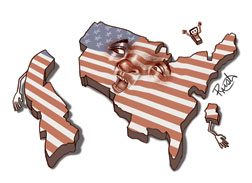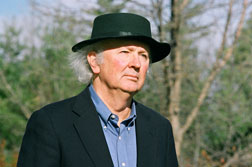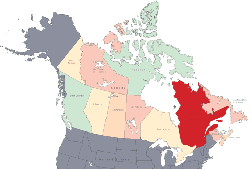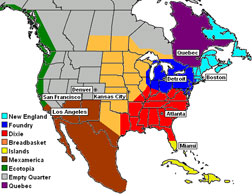How Is America Going To End?
Who's most likely to secede?
In the American end times, our government will take one of two forms. One possibility is that federalism will give way to an all-powerful central government. (In yesterday's global-warming thought experiment, this was the climate strongman scenario.) The other option is decentralization—in the absence of a unifying national interest, the United States of America will fragment and be supplanted by regional governance.
America was designed to avoid these two extremes—to keep the states and the national government in balance. The United States will end when the equilibrium mandated by the Constitution no longer holds. Tomorrow, I'll look at how the country might transition from democracy to totalitarianism. Today, I'll focus on America's disintegration.
Predictions of modern America's collapse usually say more about the speaker than about the country's condition. Igor Panarin, the Russian political scientist who believes the United States will break into six pieces in 2010, seems to be extrapolating from what happened to the Soviet Union. Texas Gov. Rick Perry, who paid lip service to secession at a tax-day rally earlier this year, was less predicting America's downfall than feeding chum to a riled-up, "Secede!"-chanting crowd. "[I]f Washington continues to thumb their nose at the American people," Perry said, "you know, who knows what might come out of that."
Eric Zuelow, a history professor at the University of New England and the editor of The Nationalism Project, argues that "loud voices" like Perry's bolster the country's strength. The fact that we can debate our country's legitimacy is a sign of national health. For the United States to fall to pieces, Zuelow says, it'll take more than a demagogue on a PA. Americans will have to come to believe they're no longer Americans.
It wasn't always certain that the states would be as united as they are today. In An Empire Wilderness, Robert D. Kaplan explains that James Madison, one of the authors of the Federalist Papers, envisioned America as "an enormous geographical space with governance but without patriotism, in which the federal government would be a mere 'umpire,' refereeing competing interests." There are regional and ideological differences in the modern United States: People in the Deep South and the Pacific Northwest eat different foods, have different accents, and (generalizing broadly) have different lifestyles and values. But as compared with a place like the USSR, a constructed nation with immense regional diversity, the United States is bound together tightly by its shared origins, a common language and culture, and a widely held belief in the country's mythologies (American exceptionalism, self-reliance, and social mobility). In times of perceived danger, Americans pull together. After 9/11, Zuelow says, "I don't care where you were in the country, the response was We've been attacked. … It wasn't, We eat grits and We eat salmon."
What kinds of countries fall apart? Jason Sorens, a political scientist at the University at Buffalo who studies contemporary secessionist movements, says that ethnicity, economics, and ideology all come into play. A secessionist sweet spot typically lies in a region with an embedded minority that has a common language and a history of prior independence. Latvia and Lithuania fit those requirements, as do the Serbs in Bosnia and Canada's Quebecois. According to Sorens' models, it's no surprise that there aren't any large-scale movements to break up the United States—the country is too prosperous and too cohesive. (Sorens' own Free State Project—a push to get libertarians to swarm New Hampshire and influence local politics—is "not a secessionist movement," he says, though "there are a lot of people [in the project] who would support that as a last resort.")
That's not to say that everyone who lives in America is content with the state of the union. As Wikipedia's "list of U.S. state secession proposals" indicates, there's no shortage of groups that want the country to split up. American secessionism, however, is less a populist movement than a collection of cranky, lonesome idealists. Thomas Naylor, the brains behind the Second Vermont Republic —a group that bills itself as "perhaps the foremost active secessionist organization in the country"—bemoans the fact that his movement shares the separatist marquee with less serious-minded folk. Naylor mentions one squadron of Long Islanders who've given their "new country" a national animal (Atlantic blue marlin) and a national crustacean (blue crab). The League of the South is also a perpetual source of heartburn for Naylor—the retro-Confederate group insists on singing Dixie at meetings and has a strange obsession with returning American spelling to its traditional Southern roots. By contrast, Naylor likes what he sees out of the Texas Nationalist Movement. That independence-espousing organization doesn't appear to be racist, homophobic, or violent, Naylor says, though on the last count "you can never be sure."
Naylor is more soft-spoken than you'd expect for someone who regularly refers to America as an "evil empire." He is 73 years old, stands a sturdy 6 feet 3, and has longish white hair that gives him the look of a founding father. A retired Duke economics professor, he was inspired to come to Vermont in 1993 after seeing an Oprah episode on downshifting your life. (One of the guests was a man who moved to Vermont to run a country inn.) In Secession: How Vermont and All the Other States Can Save Themselves From the Empire, Naylor writes that American civilization "promotes affluenza, technomania, e-mania, megalomania, robotism, globalization, and imperialism." The Second Vermont Republic aspires to dissolve the union nonviolently and return Vermont to the independent status it held briefly in the late 18th century. Naylor believes the mystique of a free Vermont or a free Novacadia —a secessionist joint venture with Maine, New Hampshire, and Canada's four Atlantic provinces—would catalyze separatism throughout America. Ben and Jerry's is "not in the ice cream business," he explains. "They [are] in the Vermont business. We're in the Vermont business also."
I'm eating lunch at an outdoor cafe in Waitsfield, Vt., with Naylor and Rob Williams, the editor of the independence-espousing Vermont Commons newspaper. Secession, according to Williams, is "as American an impulse as apple pie." The Declaration of Independence marked the United States' secession from the British Empire. New England considered leaving the U.S. during the War of 1812, and Maine seceded from Massachusetts in 1820. Up until the Civil War, nobody questioned the idea that breaking free from the central government was legal and justifiable under the right circumstances. Today, Williams admits, mutual revulsion at the idea of secession is one of the few things the left and right can agree on. "Abraham Lincoln did a number on us," he says.
Naylor ultimately wants the Vermont legislature to call a statewide convention to consider articles of secession. That's not happening soon, even in the land of Bernie Sanders. Kirkpatrick Sale, the founder of the secessionist think tank the Middlebury Institute (and, at 72, the other grand old man of American secessionism), acknowledges that it was "in the depths of the Bush administration that this secession movement began and gained strength." Sale feared that left-wing enchantment with Barack Obama would hinder his cause, but he's been heartened by the progress of the "state sovereignty movement"—bills being pushed by state lawmakers who want to curb federal authority.
At this point, the state sovereignty push reeks of wishful separatist thinking. But the fact that secession is a marginal idea today doesn't mean it won't ever come to pass. How might secession transition from a fringe idea to a country-ender? In my conversations with economists, political scientists, and futurists, three broad themes came up that I found the most persuasive: economic collapse, the rise of localism, and North American reshuffling.


Peter Schiff is one of the recession's biggest winners. The Connecticut stockbroker, once a cable news piñata on account of his predictions of economic catastrophe, is now celebrated for his eerily accurate prophecies. Schiff, who has formed an exploratory committee in anticipation of a potential 2010 Senate run, believes America is going under thanks to a "phony economy" built on borrowed cash. The stimulus, he argues, will make things worse by temporarily taping over structural problems with unsustainable borrowing and spending. "After we do the wrong thing and destroy [the value of] our money, are we going to become a totalitarianist country?" Schiff asks. "Will there be a Soviet revolution or an American revolution?"
Let's say there's an American revolution—who leaves first? Once the feds "start imposing just huge taxes," Schiff says, the states that have to pay more in than they're getting back out will pull their stars off the flag. Schiff lists Texas and California as potential pull-out candidates, whereas "Florida probably wants to stay because of all the Social Security money."
If taxation doesn't cause a mass revolt, economic polarization could yank everything apart. "The Sun Belt states and the interior West are growing faster than the Midwest," says secession scholar Jason Sorens. "If they get rich enough, they might see their membership in the U.S. as burdensome if they have to support dying industries in Ohio and New York." (Sorens apparently hasn't considered the possibility that Cleveland and Buffalo will become America's oasesthanks to global warming.)
A place like Texas has the means to support itself as an independent country. What it needs is an ideological spark. Northern Italy's Lega Nord could be a potential model. Rather than emphasize a linguistic or ethnic difference, the political party has espoused independence for economic reasons. In Italy's 1996 general elections, the political party won 10 percent of the vote nationwide by calling on rich, conservative northerners to go it alone in a state called Padania. In the last eight years, Lega Nord has moderated its separatist rhetoric as it's become a part of Silvio Berlusconi's coalition government. (Still, the party is regularly accused of xenophobia.)
For secession to tear the United States to pieces, somebody has to jump first. "As states leave, more states want to leave," Schiff says, "which is why the government will try to say you can't leave, or we'll invade you." The Second Vermont Republic's Thomas Naylor agrees that someone has to set a secessionist example. But Naylor doesn't believe that the U.S. would try to "enslave free Vermont." (His farcical suggestion: "They could burn all the maples and destroy all the black-and-white Holsteins.") If American troops did invade Montpelier, he says, it would destroy America's moral authority just as attempts to stamp out anti-Communist movements in the Soviet Bloc eventually undercut the USSR.


...
The Institute for the Future's Jamais Cascio contends that "very few national entities maintain their structural coherence for much more than a couple hundred years." In Cascio's 50-year forecast "The Long Crisis," the United States breaks into eight pieces. By 2054, the Midwestern states have invaded the Gulf and Southern Federation, with New Columbia (the Atlantic seaboard) and Pacifica (the West coast) supplying arms to the Southern insurgents.
What could precipitate such a schism? Cascio foresees a shift to localism—a focus on eating where we live, on supplying our own energy (micro-wind and micro-solar), and on fabricating our own products (and possibly weapons) with industrial-grade 3-D printers. Allen Buchanan, the author of Secession: The Morality of Political Divorce From Fort Sumter to Lithuania and Quebec, says that (while he's not predicting this) climate change, a pandemic, or an economic collapse could lead to what he calls sauve qui peut secession—"let him save himself who can."
This idea of a reversion back to a time when no kingdom or ruler had enough power to control a large territory squares with collapsists like Dmitry Orlov and James Howard Kunstler, who argue that America will revert to pre-industrial times in the post-petroleum age. In an essay called "Thriving in the Age of Collapse," Orlov writes that a dearth of oil will force people "to stay put most of the time, perhaps making seasonal migrations, and to make use of what they have available in the immediate vicinity." Not one to dwell on the negative, the Russian writer points out that societal collapse boosts one's health and vigor: "[T]he air will be much cleaner, there will be no traffic jams, … [l]ocal culture will make a comeback, [and p]eople will get plenty of exercise walking around, carrying things, and performing manual labor."

In 1995, a referendum on Quebec independence failed by less than 1 percent of the vote. What might have happened if Quebec had broken away, and Canada were severed into Western and Eastern chunks? As in Italy, where tax receipts from the wealthy North prop up the more-destitute South, Canada's richer west side (Alberta and British Columbia) helps support the poorer Maritime provinces back east. Without Quebec keeping the country contiguous, Canada's Westerners might want to go it alone rather than export their riches..
.
What would happen to the U.S. upon Canada's disintegration? North America's borders have remained pretty much static for the last century. (The same can't be said for, say, Europe and Africa.) But this stability shouldn't imply that our dividing lines make sense. In 1981's Nine Nations of North America, Joel Garreau argued that the continent's borders don't reflect how we live. Garreau's nine nations map—which highlighted regions where people share common values, culture, and natural resources—wasn't intended to be predictive of a future breakup. Still, something like Canadian breaking could bring on a continental reordering. British Columbia might join Washington and Oregon to form a Pacific Northwest partnership—Ecotopia? The Republic of Cascadia?—and the Maritime provinces could flit away from Canada to become a part of Novacadia.
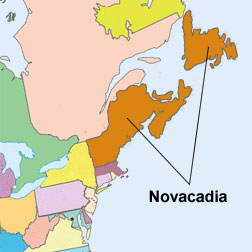

In the absence of logical borders, how have we stayed intact? Mostly because the Quebecois remain the continent's only serious nationalist movement—a sizable embedded minority with its own identity and its own language. One path to continental disintegration is the radicalization of America's Quebecois: Spanish-speaking immigrants. No matter what immigration laws go on the books, the U.S. will still need cheap labor, and Mexicans and Central Americans will continue to head north to pursue this country's higher wages. By 2050, by which time whites will be a minority in America, Hispanics are expected to make up 29 percent of the population.
Can we all just get along? In a lecture at the 2006 Pop!Tech conference, Juan Enriquez—the author of The Untied States of America: Polarization, Fracturing, and Our Future—said it depends on how we treat Spanish speakers. If Lou Dobbs and the English-only crowd become the architects of America's foreign policy, Enriquez argues, America is in peril. "How you treat people today is going to be remembered for a long time," Enriquez says, noting that the license plates in Quebec read Je me souviens—I remember.
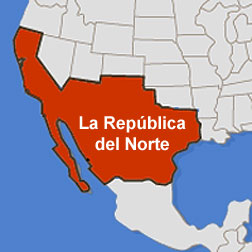
Charles Truxillo, a professor at the University of New Mexico, says it's too late to save the United States we know today. Truxillo believes this century will see the birth of La República del Norte, a sovereign "Mexicano nation" in what's now the American Southwest. "The U.S. ripped these areas off from Mexico in 1848," he says, and the debt has come due. Rather than fight what's inevitable, Truxillo says North America should toss out the melting pot and learn to love "autonomous sovereign zones"—a French-speaking nation for the Quebecois, a Spanish-speaking nation for the Latinos, and an English-speaking nation for the Anglophones. It's no accident that, when you ponder both secession and climate change, the most convincing end-of-America scenarios involve Canada and Mexico. For the last 160 years, America has been the hemisphere's alpha dog. But the United States is not a closed system—we're tightly integrated with our neighbors, and the forces that might crush the U.S. will also affect them. One conspiracy theory, pushed by loony swift-boat-truther Jerome Corsi, has it that the U.S., Canada, and Mexico will soon share a common passport, currency, and military. While the propaganda about the looming North American Union is completely bogus, it's certainly true that we are not alone. Take away the artificial borders and we're all just North Americans, clinging to each other for life. If America ends, so will Canada and Mexico. And if Canada or Mexico goes down the tubes, we won't be long for this continent either. Correction, Aug. 14, 2009: A map of Canada embedded on this article page originally omitted New Brunswick and Prince Edward Island. The map has been replaced.

